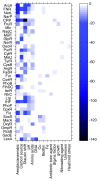DISTILLER: a data integration framework to reveal condition dependency of complex regulons in Escherichia coli
- PMID: 19265557
- PMCID: PMC2690998
- DOI: 10.1186/gb-2009-10-3-r27
DISTILLER: a data integration framework to reveal condition dependency of complex regulons in Escherichia coli
Abstract
We present DISTILLER, a data integration framework for the inference of transcriptional module networks. Experimental validation of predicted targets for the well-studied fumarate nitrate reductase regulator showed the effectiveness of our approach in Escherichia coli. In addition, the condition dependency and modularity of the inferred transcriptional network was studied. Surprisingly, the level of regulatory complexity seemed lower than that which would be expected from RegulonDB, indicating that complex regulatory programs tend to decrease the degree of modularity.
Figures



Similar articles
-
Evidence classification of high-throughput protocols and confidence integration in RegulonDB.Database (Oxford). 2013 Jan 17;2013:bas059. doi: 10.1093/database/bas059. Print 2013. Database (Oxford). 2013. PMID: 23327937 Free PMC article.
-
The condition-dependent transcriptional network in Escherichia coli.Ann N Y Acad Sci. 2009 Mar;1158:29-35. doi: 10.1111/j.1749-6632.2008.03746.x. Ann N Y Acad Sci. 2009. PMID: 19348629
-
Bacterial regulon modeling and prediction based on systematic cis regulatory motif analyses.Sci Rep. 2016 Mar 15;6:23030. doi: 10.1038/srep23030. Sci Rep. 2016. PMID: 26975728 Free PMC article.
-
The hierarchic network of metal-response transcription factors in Escherichia coli.Biosci Biotechnol Biochem. 2014;78(5):737-47. doi: 10.1080/09168451.2014.915731. Epub 2014 Jun 17. Biosci Biotechnol Biochem. 2014. PMID: 25035972 Review.
-
Defining bacterial regulons using ChIP-seq.Methods. 2015 Sep 15;86:80-8. doi: 10.1016/j.ymeth.2015.05.022. Epub 2015 May 29. Methods. 2015. PMID: 26032817 Free PMC article. Review.
Cited by
-
Effect of genomic distance on coexpression of coregulated genes in E. coli.PLoS One. 2017 Apr 18;12(4):e0174887. doi: 10.1371/journal.pone.0174887. eCollection 2017. PLoS One. 2017. PMID: 28419102 Free PMC article.
-
Detailing regulatory networks through large scale data integration.Bioinformatics. 2009 Dec 15;25(24):3267-74. doi: 10.1093/bioinformatics/btp588. Epub 2009 Oct 13. Bioinformatics. 2009. PMID: 19825796 Free PMC article.
-
Network portal: a database for storage, analysis and visualization of biological networks.Nucleic Acids Res. 2014 Jan;42(Database issue):D184-90. doi: 10.1093/nar/gkt1190. Epub 2013 Nov 23. Nucleic Acids Res. 2014. PMID: 24271392 Free PMC article.
-
Toward the dynamic interactome: it's about time.Brief Bioinform. 2010 Jan;11(1):15-29. doi: 10.1093/bib/bbp057. Epub 2010 Jan 8. Brief Bioinform. 2010. PMID: 20061351 Free PMC article. Review.
-
Genome-scale co-expression network comparison across Escherichia coli and Salmonella enterica serovar Typhimurium reveals significant conservation at the regulon level of local regulators despite their dissimilar lifestyles.PLoS One. 2014 Aug 7;9(8):e102871. doi: 10.1371/journal.pone.0102871. eCollection 2014. PLoS One. 2014. PMID: 25101984 Free PMC article.
References
-
- Resendis-Antonio O, Freyre-Gonzalez JA, Menchaca-Mendez R, Gutierrez-Rios RM, Martinez-Antonio A, Avila-Sanchez C, Collado-Vides J. Modular analysis of the transcriptional regulatory network of E. coli. Trends Genet. 2005;21:16–20. - PubMed
-
- Salgado H, Gama-Castro S, Peralta-Gil M, Diaz-Peredo E, Sanchez-Solano F, Santos-Zavaleta A, Martinez-Flores I, Jimenez-Jacinto V, Bonavides-Martinez C, Segura-Salazar J, Martinez-Antonio A, Collado-Vides J. RegulonDB (version 5.0): Escherichia coli K-12 transcriptional regulatory network, operon organization, and growth conditions. Nucleic Acids Res. 2006;34:D394–D397. - PMC - PubMed
-
- Shen-Orr SS, Milo R, Mangan S, Alon U. Network motifs in the transcriptional regulation network of Escherichia coli. Nat Genet. 2002;31:64–68. - PubMed
-
- Luscombe NM, Babu MM, Yu H, Snyder M, Teichmann SA, Gerstein M. Genomic analysis of regulatory network dynamics reveals large topological changes. Nature. 2004;431:308–312. - PubMed
Publication types
MeSH terms
Substances
LinkOut - more resources
Full Text Sources
Molecular Biology Databases

